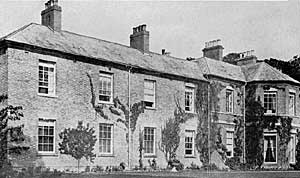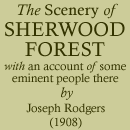< Previous | Contents | Next >
COCKGLODE
"Yes, I will be thy priest, and build a fane
In some untrodden region of my mind,
Where branched thoughts, new-grown with pleasant pain,
Instead of pines shall murmur in the wind."
John Keats."Other trees, tufting crag or hill, yield to the form and sway of the ground, clothe it with soft compliance, are partly its subjects, partly its flatterers, partly its comforters. But the pine rises in serene resistance, self-contained, . . . upright, fixed, spectral, as troops of ghosts standing on the walls of Hades, not knowing each other—dumb for ever."
Modern Painters, vol. v.

Avenue of Scotch Firs, Cockglode.
One can imagine this house, standing alone in a grove of old forest trees, to have been erected from the same love of nature that inspired Sir Thomas Wortley to build the Lodge at the summit of the Crags on Wharncliffe Chase "for his plesor to here the hartes bel." Its name speaks of the winged creatures of the wood.
The most remarkable feature within these grounds is the avenue of Scotch Firs near the Ollerton entrance. The fir is always a stately tree, and being planted here in formal lines has a grand and majestic look. Unfortunately it does not attain to any great age, for the roots scarcely penetrate into the sandy soil, and the rich loam of the surface is very thin. From this cause the avenue has lost some of its finest trees. On counting the rings of one which died in 1877, it was found to be 150 years old.
It is pleasant on a summer's day to rest at the foot of one of these tall firs, for in this secluded garden of the forest, the commonest sounds of nature, even the droning hum of the bee, or the chirp of the grasshopper, are full of poetic feeling. Sometimes, during the deepening twilight of the spring, the nightingale makes the wood re-echo with its sweet melancholy strains. In early summer the cuckoo haunts these firs all day; its notes varied by the song of the thrush or the blackbird, the quick tapping of the nuthatch, or the wild cry of the woodpecker. Perhaps a slight stir is heard among the trees overhead, and a squirrel descends to the ground from his nest; he suddenly stops, and, with head poised on one side, fixes his bright eye upon the intruder, but seeing no hostile movement, proceeds very leisurely on his way. This morning there might be noticed under the garden paling, looking quite dazed in the sunlight, a young owl that has evidently wandered from its nest; whilst the loud note of warning is often sounded by the rustic youth near the hen-coops, to scare away sly Reynard.

Moonlight at Cockglode.
When Sherwood was a Royal Forest, it is said that the Ranger's Lodge for the Hays of Birkland and Bilhagh stood here, and in early times would have been in the occupation of an official of the Crown. In the year 1818, however, this last remnant of the Forest passed into the hands of the Duke of Portland (though not finally transferred until 1828), when the advowson of St. Mary-le-bone was given by the Duke to the Crown in exchange. Shortly afterwards the Duke disposed of that portion to the east of the Centre Riding to Earl Manvers in consideration of certain properties at Cuckney and Hol-beck Woodhouse, adjoining Welbeck. It is now part of the Thoresby estate.
The present house at Cockglode, the only dwelling house remaining within the actual forest, has been built about 133 years. From the time of its erection (1774) until his death in 1797, it was in the occupation of Dr. George Aldrich, M.D., who left an annuity of £12 10s. to enable a service to be held every Sunday in Ollerton Church, where he and his wife are buried. After Dr. Aldrich's death it became the residence of Sir Robert Shore Milnes, Bart., a member of the same family as the late Lord Houghton. Sir Robert, who served in early life in the Royal Horse Guards Blue, had been Governor of Martinique, and afterwards of Quebec, and his wife being a Bentinck, he was probably from that fact induced to settle here. He was created a Baronet in 1801, and died in December, 1837.

Cockglode, c. 1910.
The next tenant of Cockglode was Colonel the Hon. Savile Henry Lumley, a younger son of Richard, fourth Earl of Scarborough, by Barbara, younger sister and co-heiress of Sir George Savile, Bart. Colonel Lumley married in 1806, Mary Henrietta, daughter of Henry Tahourdin, Esq., of Sydenham, Kent. He died in 1846, and was buried at Edwinstowe. His widow remained tenant of Cockglode until her death in July, 1869, when the house passed into the hands of Cecil George Savile Foljambe, Esq., who, in that month, married Louisa Blanche, eldest daughter of Frederick John Howard, Esq., of Compton Place, Sussex, and Lady Fanny his wife, only sister of the seventh Duke of Devonshire. She died in October, 1871, leaving an only surviving son, and he married as his second wife, July 21, 1877 (her cousin) Susan Louisa, eldest daughter of Colonel William Henry Frederick and Lady Emily Cavendish, of West Stoke, Sussex. Mr. Cecil Foljambe was M.P. for North Nottinghamshire from 1880 to 1885, and for the Mansfield Division of Notts, 1885 to 1892, when, on Mr. Gladstone's becoming Prime Minister for the fourth time, he was raised to the peerage in 1893 (his grandfather, the third Earl of Liverpool's second title of Hawkesbury being revived in his favour, he being his principal representative and heir) as Baron Hawkesbury of Haselbech, in the County of Northampton, and of Ollerton, Sherwood Forest, in the County of Nottingham. Lady Selina Jenkinson, second daughter of the last named Earl of Liverpool, having first married on the 15th of August, 1833, Lord Milton, who died on the 8th of November, 1835, ten years afterwards married, as his second wife, George Savile Foljambe, Esq., of Osberton, Notts, by whom she had issue Cecil George Savile Foljambe, Lord Hawkesbury; on whom, on the accession to power of the Liberal Party in 1906, the King was pleased to confer the office of High Steward of his Majesty's Household, and to bestow upon him the further title of Earl of Liverpool which was borne by his maternal grandfather, Cecil Charles Cope Jenkinson, the third Earl.
The Earl of Liverpool spent twenty-eight years at Cockglode, removing to his Yorkshire home, Kirkham Abbey, in 1897; where he died after a long and painful illness on the 23rd of March, 1907.
Of whom, as of the author of Sylva, from whom the Earl of Liverpool is descended, it may with truth be said, he was "a lover of the forest and of all appertaining to forestry."
< Previous | Contents | Next >
